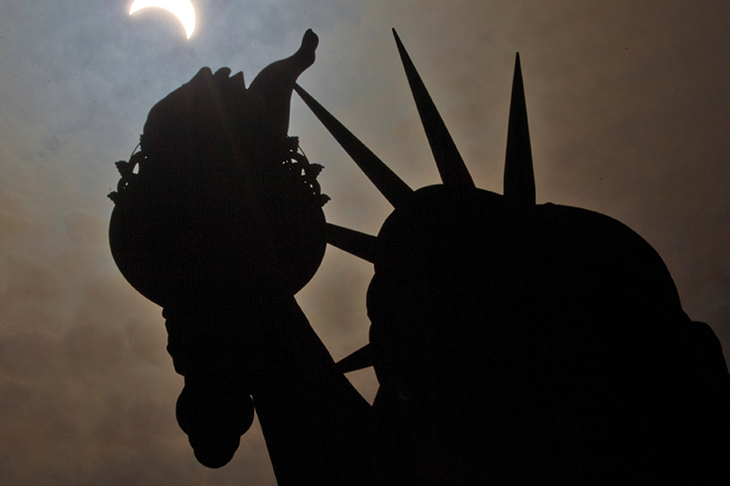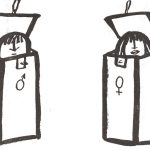Immigrants to the United States in the late 19th century discovered in Upper New York Bay, after a long, uncomfortable trans-Atlantic journey, a real portal and a symbolic one. There was Ellis Island: designer, William A. Boring. Then there was the Statue of Liberty on neighboring Bedloe’s Island: designer, Frédéric-Auguste Bartholdi. The first was a practical introduction to America, where you got processed; the second a more mystical one, where you got inspired.
It’s a good moment to publish an account of the Statue of Liberty, perhaps the world’s most famous sculpture. One reason: in London there’s an evolving debate about what a monument should be, stimulated by the clumsy Holocaust Memorial proposed near Parliament. The other reason: never have American principles of liberty been under more intense international scrutiny. Dave Eggers caught this mood last year in Her Right Foot, where he found Liberty’s pedal extremity, striding forth, to be a ‘powerful message of acceptance’.
Everyone recalls, at some level, Emma Lazarus’s lines from ‘The New Colossus’: ‘Give me your poor, your huddled masses yearning to be free.’ Exactly so. That’s Liberty’s message to the ‘wretched refuse’ of Europe. And we all remember that Liberty was France’s ‘gift’ to the United States. But the standard history of Liberty is Marvin Trachtenberg’s, now over 40 years old. So, Francesca Lidia Viano’s revisionist account of the statue’s ‘unlikely origins’ is a welcome corrective to settled opinion. Viano is a Harvard academic specializing in trans-Atlantic economic and political exchanges. Sentinel was originally published in Italian as La statua della Liberta: Una storia globale.
Essentially, three people were involved in this global history. First, an eccentric freemason intello called Edouard Lefebvre de Laboulaye, whose idea it was. He was the sort of person who, if invited to attend a magnetic séance in a fumoir, most likely would accept. Second, Bartholdi himself, a successful professional sculptor from Alsace, but some way behind the Parisian avant-garde. Third, the engineer, Gustave Eiffel. Like Bartholdi, Eiffel was a talented provincial — rejected by the grand Ecole Polytechnique — and almost hallucinant, deranged, by ambition.
Although Sentinel is based more in biography than aesthetics, Viano has done impressive art historical research. She suggests several iconographic sources of Liberty with her conversation-piece helmet and raised arm clutching a torch. For example, Auguste Dumont’s ‘Le Génie de la Liberté’ of 1836, athwart the July Column in the Bastille; Ludwig von Schwanthaler’s 1850 personification of Bavaria in Munich; and, of course, Delacroix’s heroic 1830 painting ‘La Liberté guidant la Peuple’ in the Louvre.
But while Liberty is a fine plastic example of the French conception of grandeur, Viano’s thesis is that, so far from being a cheerful present from one nation to another, she is, in fact, a subversive and occult statement. Liberty is an ‘ambivalent icon of colonial domination’.
Indeed, beyond the easy-to-read symbolism, Liberty is exotic, even infernal. And as much anti-British in sentiment as she is pro-American, because Liberty represents competitive French interests. And when I say ‘she’, even that is now in doubt. Of the many ambiguities on Bedloe’s (now Liberty) Island, one is gender itself. Are we looking at the female Artemis and Demeter, or the male Orpheus, Hermes and Bacchus?
Certainly, Bartholdi was an orientalist, then a fashionable taste in Paris’s artistic milieu. He took photographs in Thebes and travelled widely. By 1867, he had finished a maquette of a sculpture intended for Suez, where French colonialists were very busy. This was ‘L’Egypte apportant la lumière à l’Asie’ and, conceptually, a precedent for the colossus on Bedloe’s Island.
When Victor Hugo visited Bartholdi’s Paris studio before Liberty was packed in 214 crates and sent to America, he found it strange, exotic and pantheist. And so it was; ancient Egypt seems to have inspired Bartholdi as much as Jeffersonian notions of free citizens bent on life, liberty and the pursuit of happiness.
Viano’s history includes squabbling about funds and sites and fussing about the plinth. Curios too: in 1876, an arm of Liberty was shown, perhaps as a teaser, in the great Philadelphia exhibition. But because Viano’s interests are in intrigue and biography, there is less about the fascinating practical matters of fabrication and Eiffel’s structural role than the subject deserves.
The process seems to have been this: a 10:1 model was made. This would have been about 15ft tall. Tacks would be placed at strategic points and then the whole would be put in a calibrated frame and the reference points made by the tacks would be scaled up using plumb lines. Wooden formers would then become full-size body parts and embossers would go to work with ‘beating sticks’ and ‘gold-beater’s hammers’. Bartholdi wanted it painted gold; in the end the unpainted copper turned green — the color, Viano wryly notes, of dollars.
This is superb scholarship, interpreted with an elegant touch and beautifully produced. Maybe it is a little overlong: Viano sometimes lets her erudition get the better of her taste for précis: so crowded into a single sentence are Pico della Mirandola, G.F. Creuzer, the Virgin Mary, Venus and Dionysus. I was almost disappointed not to find Huysmans, Donald Duck and Ronald Reagan involved as well.
Liberty was inaugurated on 28 October 1886. Very soon, this peculiar, pagan demonstration of French ambition, an exile abroad, became the most popular, and now, thanks to Viano’s fine book, the most ambiguous, symbol of America. Gender-fluid too.
This article was originally published in The Spectator magazine.


















